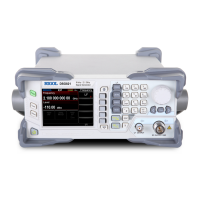RIGOL Chapter 2 Performance Verification Test
2-4 DSG800 Performance Verification Guide
10. Calculate the System Error (the input attenuation of the signal analyzer is 10 dB) = A2 - A1
and record the result.
11. Keep the connections shown in Figure 2-1
(b) unchanged, press Mode Preset to restore the
signal analyzer to its factory setting and set the output amplitude of DSG800 according to
Table 2-2.
Table 2-2 Output Amplitude of DSG800
Output Amplitude
-10 dBm
-80 dBm
Note: Here, the output amplitude of DSG800 is used as the amplitude Reference Value.
Different output amplitudes correspond to different reference values.
12. Each time the output amplitude of DSG800 is changed, modify the configurations of the signal
analyzer accordingly.
a) Set the frequency reference input to external.
b) Set the span to 100 Hz.
c) Set the reference level to -20 dBm.
d) Set the input attenuation to 10 dB.
e) Set the resolution bandwidth to 1 Hz.
f) Set the sweep time method to accurate.
g) Set the self-calibration to normal and perform all of the calibration items.
13. Set the output frequency of DSG800 and the center frequency of the signal analyzer according
to Table 2-1 (the center frequency of the signal analyzer corresponds to output frequency of
DSG800).
14. Each time the center frequency is changed, press Single and wait for the instrument to finish
a sweep; then, press Peak Search to find the maximum peak and record the measurement
result A3 to the Test Record Form.
15. Calculate the Global Error = A3 - Reference Value and record the result.
16. Calculate the Amplitude Accuracy = |Global Error - System Error| and compare the
measurement result with the specification.

